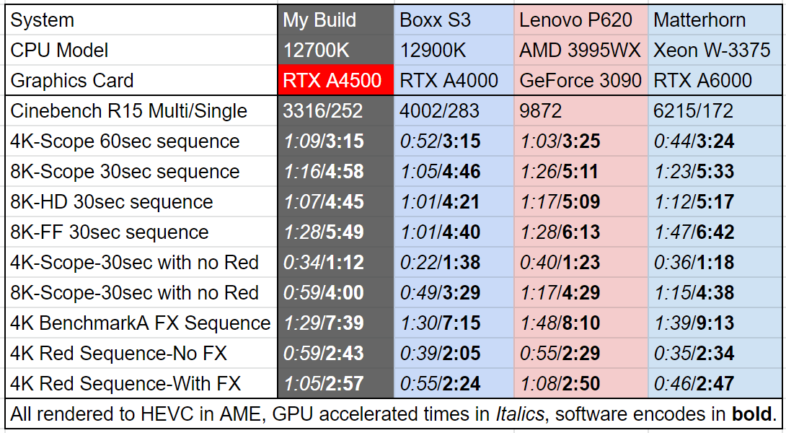NVidia has quite a long selection of professional GPUs available based on the Ampere generation chips. While this offers users finer gradations in pricing and performance, it can be more confusing than previous generations, especially since they have dropped the “Quadro” branding. My understanding is that one of the main reasons there are so many options is not just the binning of chips, but supply chain issues with the rest of the parts on the board. Unlike gaming cards where a source part can be swapped and a new revision of the card can be produced without much issue, the professional cards that have been certified by software vendors with very precise conditions, need to maintain those exact specifications. So different versions are created using easier to source parts, and certified again, allowing both cards to be produced as separate options. The main additions to the series are the A4500 and the A5500, which fit as expected between the existing A4000, A5000, and A6000 cards. The A4500 which I have been testing, sits nearly dead center between the A4000 and A5000 on all paper specs (cores, memory, teraflops, etc.), while the A5500 nearly matches the A6000 in processing power, but with the same memory limits as the A5000. While these new cards were announced in the spring, I am finally getting the chance to test one out now.

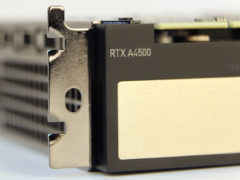 The A4500 is a step above my previous favorite option, the single slot A4000, which I got to try out in the Boxx S3 this spring. The A4500 is more powerful, requiring two slots, and an 8pin PCIe power connector. It has 16% more CUDA cores, and 25% more memory, at 7168 cores and 20GB of DDR6 RAM. This raises it to a total of 23.7 Teraflops of Single Precision compute power, which is nearly 50% more than the last generation’s top Quadro RTX 6000/8000. So NVidia clearly has been seeing some tremendous performance gains in the newest generation of cards. The fact that it requires two slots is less of an issue as it has been in the past, as many motherboards are now designed for this, and the two slot cooling solution should be quieter under load, which may be beneficial to editors.
The A4500 is a step above my previous favorite option, the single slot A4000, which I got to try out in the Boxx S3 this spring. The A4500 is more powerful, requiring two slots, and an 8pin PCIe power connector. It has 16% more CUDA cores, and 25% more memory, at 7168 cores and 20GB of DDR6 RAM. This raises it to a total of 23.7 Teraflops of Single Precision compute power, which is nearly 50% more than the last generation’s top Quadro RTX 6000/8000. So NVidia clearly has been seeing some tremendous performance gains in the newest generation of cards. The fact that it requires two slots is less of an issue as it has been in the past, as many motherboards are now designed for this, and the two slot cooling solution should be quieter under load, which may be beneficial to editors.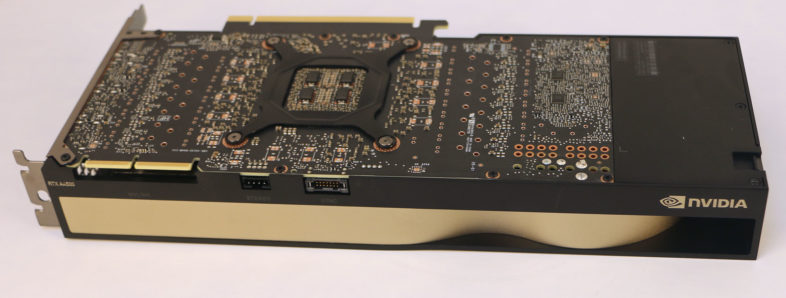
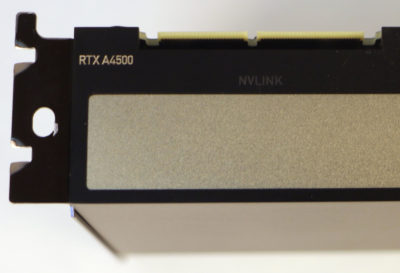 Besides the obligatory PCIe 4.0 x16 connector, the A4500 also adds an NV-Link connector on top that the A4000 does not have, allowing two A4500 cards to be combined, for 14,376 cores accessing 40GB of RAM, if your application can leverage the cards in parallel, which mine can not very well. But in that case, a pair of A4500s should be able to exceed the performance of a single A6000 for much lower cost. Speaking of cost, Google lists the MSRP at $2500, but unlike most recent GPU history, the cards are listed for sale at much lower prices than that. So it is an interesting time to buy a GPU, as markets adjust to shifts in crypto-currency mining, but that means there should be some good deals available as that sorts itself out.
Besides the obligatory PCIe 4.0 x16 connector, the A4500 also adds an NV-Link connector on top that the A4000 does not have, allowing two A4500 cards to be combined, for 14,376 cores accessing 40GB of RAM, if your application can leverage the cards in parallel, which mine can not very well. But in that case, a pair of A4500s should be able to exceed the performance of a single A6000 for much lower cost. Speaking of cost, Google lists the MSRP at $2500, but unlike most recent GPU history, the cards are listed for sale at much lower prices than that. So it is an interesting time to buy a GPU, as markets adjust to shifts in crypto-currency mining, but that means there should be some good deals available as that sorts itself out.
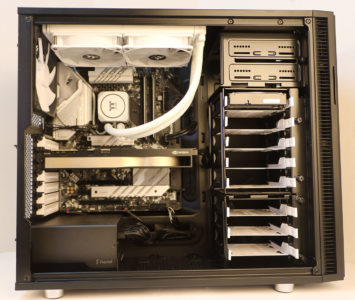 I am testing this card in my new 12700K based testbed, which admittedly makes direct comparisons to my earlier data harder to make, but for most video editors, any A-series GPU will be more than sufficient for their needs, and it really comes down to finding a good deal. Unless you are manipulating huge 3D models, (in which case GPU memory should dictate your selection) you are probably not going to see a huge performance difference in editing applications. My battery of benchmark tests in the Adobe applications return very similar performance across all of NVidia’s Ampere generation cards.
I am testing this card in my new 12700K based testbed, which admittedly makes direct comparisons to my earlier data harder to make, but for most video editors, any A-series GPU will be more than sufficient for their needs, and it really comes down to finding a good deal. Unless you are manipulating huge 3D models, (in which case GPU memory should dictate your selection) you are probably not going to see a huge performance difference in editing applications. My battery of benchmark tests in the Adobe applications return very similar performance across all of NVidia’s Ampere generation cards.
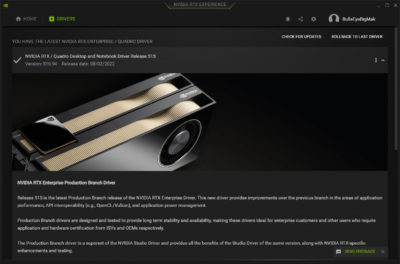 One other benefit over the GeForce cards, is the option to use the RTX Desktop manager, and the new RTX Experience software. This replaces Quadro Experience, as the professional version of NVidia’s popular GeForce Experience utility. While it can keep your drivers up to date, the feature I think is most valuable is the option to do desktop screen captures at up to 8K resolution, like with my Dell UP3218K monitor, and more significantly for most people, with support for HDR. This is a big deal to me as I try to make tutorials about HDR editing, and previous versions either didn’t support capturing from certain applications, or tagged the output files incorrectly, making it harder to edit them in Premiere.
One other benefit over the GeForce cards, is the option to use the RTX Desktop manager, and the new RTX Experience software. This replaces Quadro Experience, as the professional version of NVidia’s popular GeForce Experience utility. While it can keep your drivers up to date, the feature I think is most valuable is the option to do desktop screen captures at up to 8K resolution, like with my Dell UP3218K monitor, and more significantly for most people, with support for HDR. This is a big deal to me as I try to make tutorials about HDR editing, and previous versions either didn’t support capturing from certain applications, or tagged the output files incorrectly, making it harder to edit them in Premiere.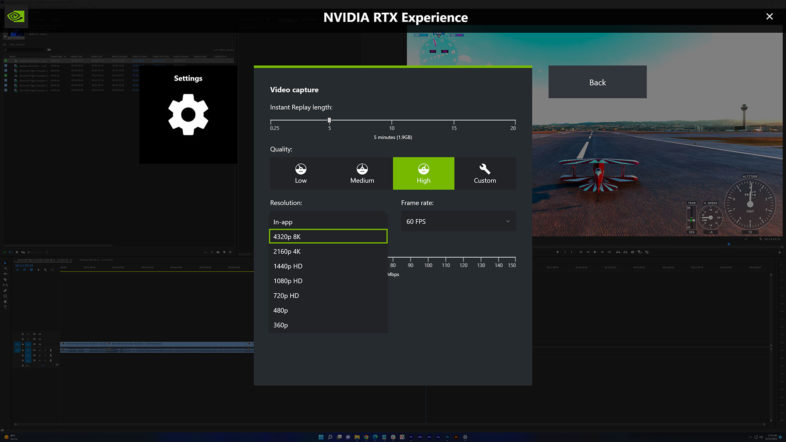
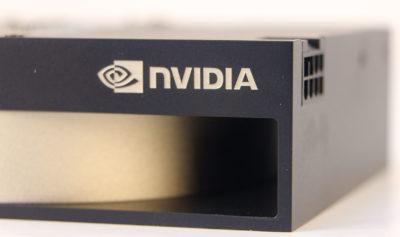 So there are a lot of options available in the professional series of cards of the Ampere generation, which should be a benefit to the end user both in terms of maximizing value and availability, after years of that being a key issue in the GPU space, courtesy of crypto-currency mining demand. And any of these cards could be highly recommended to any video editor or VFX artist. One benefit of stepping up to the dual slot solution in the A4500 is that it should run quieter than the single slot A4000 at full load, which may be a factor for some editors who have their workstations in close proximity to their listening environments. But any of the A-series (formerly Quadro) cards will work great in the Adobe apps, as well as most other NLEs.
So there are a lot of options available in the professional series of cards of the Ampere generation, which should be a benefit to the end user both in terms of maximizing value and availability, after years of that being a key issue in the GPU space, courtesy of crypto-currency mining demand. And any of these cards could be highly recommended to any video editor or VFX artist. One benefit of stepping up to the dual slot solution in the A4500 is that it should run quieter than the single slot A4000 at full load, which may be a factor for some editors who have their workstations in close proximity to their listening environments. But any of the A-series (formerly Quadro) cards will work great in the Adobe apps, as well as most other NLEs.

